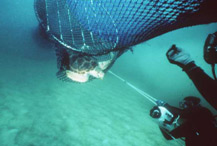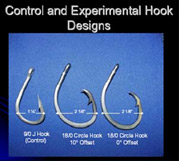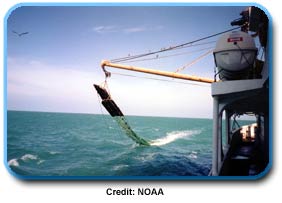|
Overview |
Major Challenges
Bycatch |
Overfishing |
Habitat Damage/Loss |
Aquaculture
Bycatch is a challenge for sustainable fishing.
The bycatch problem:
When people are fishing, creatures like marine mammals, sea turtles, and seabirds often get caught in their nets or lines. These mistakenly caught creatures are called bycatch. To these air breathers, getting caught in a fishing line or net is almost certain death because they will drown. Other kinds of bycatch include young fish that are too small to be sold at market and other species of fish and invertebrates outside the intended catch.
Bycatch results in a lot of unnecessary waste. If fishers are trying to catch and sell shrimp, they may also net sea turtles, small fish, and other invertebrates, all of which will be discarded. A recent study found that for every five pounds of seafood caught in United States waters, at least one pound will be discarded. This statistic is even more dramatic in the shrimp industry for every one pound of shrimp caught, three to ten pounds of other animals are discarded.
The bycatch solution:
Consumer power:
People who buy seafood have a tremendous amount of power. We need to train ourselves to buy from fishers that practice environmentally friendly fishing practices. There are several sites that offer a free 'wallet card.' Consumers can keep these cards in their wallets to use as a reference when they are shopping or dining out. It helps to determine which species of fish to buy or order, and can then support the harvesting of fish that are being caught sustainably.
For more information, see:
http://www.blueocean.org/pdfs/miniguide_color.pdf
This site allows you to print a 'wallet card' which you can carry with you and share with your friends and family.
http://www.mbayaq.org/cr/SeafoodWatch/web/sfw_regional.aspx?region_id=6
This site allows you to select your region of the country and download a guide specifically for where you live. For example, you can determine which type of tuna in your area is dolphin safe.
Technology:
Advances in technology have made it possible for fishers to use methods that help them decrease bycatch and even earn more money. Laws on occasion require fishers to use this technology or face severe fines. Some of these technologies are:
 Turtle Excluder Devices (TEDs): Turtles have been a hard-hit species because they tend to migrate through the paths of the fishers and get caught in their nets and lines. The turtles then drown because they are unable to return to the surface to take a breath. TEDs are a series of bars located inside the net which allow for smaller fish to pass through and remain inside. Should a larger animal, such as a sea turtle, get trapped in the net, it is then guided out of the net through a flap. This device has prevented the drowning of countless sea turtles as well as helps to reduce the number of larger fish bycatch. Turtle Excluder Devices (TEDs): Turtles have been a hard-hit species because they tend to migrate through the paths of the fishers and get caught in their nets and lines. The turtles then drown because they are unable to return to the surface to take a breath. TEDs are a series of bars located inside the net which allow for smaller fish to pass through and remain inside. Should a larger animal, such as a sea turtle, get trapped in the net, it is then guided out of the net through a flap. This device has prevented the drowning of countless sea turtles as well as helps to reduce the number of larger fish bycatch.
- Tori Lines: Sea turtles are not the only species harmed from fishing practices. Seabirds are also in danger of becoming entangled in long fishing lines called "longlines." In longline fisheries, a boat will have bait lines that are dragged behind it, and can sometimes be as long as 130 km (81 miles). These lines can carry thousands of hooks baited for larger fish such as tuna and sea bass. Seabirds, such as the albatross that fly overhead, dive down to scoop up the bait on the hooks and in the process get tangled in the longlines. The fishers may not even be aware this is happening because the lines stretch so far from the boat. Tori lines are longlines that have colored, flapping streamers attached to them in order to scare the birds and prevent them from diving down toward the lines.
 Circle Hooks on Longlines: Seabirds are not the only bycatch on longlines. Often times other animals, such as sea turtles, get caught in the hooks that are attached to the longlines. The original hook used (the J-hook) would easily snag a passing animal. The newly-designed circle hook cannot as easily catch an animal swimming by. It is reported that using the circle-hooks has decreased the loggerhead sea turtle from being hooked by 65% and the leatherbacks by nearly 90%. Circle Hooks on Longlines: Seabirds are not the only bycatch on longlines. Often times other animals, such as sea turtles, get caught in the hooks that are attached to the longlines. The original hook used (the J-hook) would easily snag a passing animal. The newly-designed circle hook cannot as easily catch an animal swimming by. It is reported that using the circle-hooks has decreased the loggerhead sea turtle from being hooked by 65% and the leatherbacks by nearly 90%.
Avoid purse seine fishing, trawling, etc., and use a more sustainable method of fishing: There are some fishing practices that simply cannot avoid excessive bycatch. Two examples are purse seine fishing and trawling. Purse seine fishing is when a boat loops a large net in a circle around a school of fish and then pulls the net in toward the boat. This method not only traps the schooling fish but pulls in any other animals in the area.
 Trawling is another method where a large net is dragged behind the boat at various depths (depending on the type of fish desired) and traps any animal in its path. Trawling is another method where a large net is dragged behind the boat at various depths (depending on the type of fish desired) and traps any animal in its path.
In both cases, the bycatch is immense. Often times sea turtles, whales, dolphins, and sharks get caught and are killed in the nets. These fishing methods should be avoided in order to protect the ocean's animal population.
Research Links Related to Sustainable Fishing:
|  | 
 | Activities Related to Sustainable
Fishing: |
| |
Sustainable Seafood
129 KB, pdf
Nice activity from NMS to make students aware of overfishing issues, can be modified for no internet access fee by printing hard copies.
|
 | Other Resources Related to Sustainable
Fishing: |
| |
Eutrophication
5896 KB, mpeg, audio clip
The effects of eutrophication are discussed in this 6 minute presentation
Credit:

Saving Crop Diversity
1434 KB, mpeg, audio clip
The Svalbard Global Seed Vault will store a backup collection of the worlds seeds to save crop diversity.
Credit:

|
|



